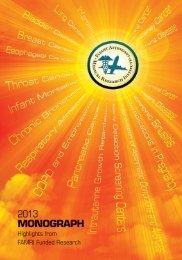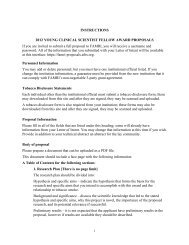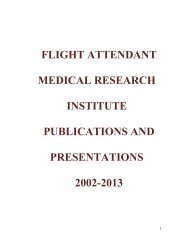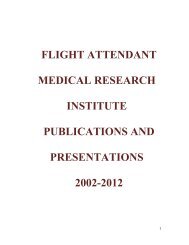MISSION
2009 compendium of FAMRI-supported research - Flight Attendant ...
2009 compendium of FAMRI-supported research - Flight Attendant ...
You also want an ePaper? Increase the reach of your titles
YUMPU automatically turns print PDFs into web optimized ePapers that Google loves.
and signaling functions), is suppressed by CS. In the Beas-2b transformed airway epithelial cell line, CS<br />
exposure decreased the antimicrobial activity of these cells and decreased transcription and secretion of the<br />
protein CCL20. The investigators also measured CCL20 in nasal washes of human subjects and found that<br />
those exposed to CS or SHS had decreased concentrations of CCL20 compared to non-smokers. Even<br />
subjects with prior, but not recent, CS exposure had low CCL20 levels implying that the immune response<br />
of epithelial progenitor cells is impaired in a permanent manner by CS exposure. Dr. Jukosky seeks to verify<br />
his preliminary data and test the production of other related antimicrobial and signaling molecules in<br />
humans with no CS exposure, prior CS exposure (6 months to 5 years ago), current SHS exposure, and<br />
subjects with current primary CS exposure (smokers). In Aim 1 the investigators are testing the hypothesis<br />
that CS alters both constitutive production and induction by lipotechoic acid (LTA) challenge of important<br />
innate immune molecules from primary human nasal epithelial (PHNE) cells. In Aim 2, the study<br />
focuses on the nasal secretions of the same volunteers and test the hypothesis that cigarette smoke exposure<br />
alters the steady-state levels of the same innate immune molecules in the nasal passage. Taken together,<br />
these studies will provide in vivo evidence of the effects of CS exposure on the immune function of<br />
PHNE and show whether prior CS exposure induces permanent changes in the progenitor cells in the<br />
nasal mucosa. The results of these studies should improve understanding of how CS exposure influences<br />
the development of infection in the upper airways, thus aiding in future prevention, diagnosis and treatment,<br />
as well as educational efforts for public awareness about the dangers of CS exposure.<br />
IMMUNE FUNCTION IMPACTED BY TOBACCO SMOKE<br />
COMPLETED RESEARCH<br />
ONTOGENY OF CYTOKINE IMMUNE RESPONSES: ROLE OF SECOND HAND TOBACCO SMOKE<br />
Deborah A. Gentile, MD; Allegheny-Singer Research Institute; CIA 2004<br />
SHS is a risk factor for the development of childhood asthma. Dr. Gentile compared subjects with and<br />
without exposure to SHS (determined by serum cotinine levels). The number of dendritic cells and<br />
CD4+CD25+ cells in those individuals without exposure was significantly higher than in those who had<br />
been exposed to SHS. No significant differences were seen in CD8+CD38+ lymphocytes or cyokine<br />
production in these two groups, but there were age-related decreases in the absolute numbers of<br />
CD4+CD25+ cells, CD8+CD38+ lymphocytes, and dendritic cells. CD8+ cells that produce interleukin<br />
(IL) 4 and IL13 also decreased in number with respect to age. However, interferon (IFN) gamma from<br />
CD8+ cells and cytokines from CD4+ cells and dendritic cells did not decrease as a function of age. These<br />
results indicate that there is a differential immune response in children related to age and related to<br />
exposure to SHS.<br />
INFECTIOUS DISEASES<br />
CURRENT RESEARCH<br />
SHS AND INFLUENZA-INDUCED RESPONSES IN NASAL EPTHELIUM<br />
Ilona Jaspers, PhD; University of North Carolina at Chapel Hill; CIA 2006<br />
Exposure to SHS has been associated with increased susceptibility to infection with respiratory viruses.<br />
Influenza virus infections continue to cause significant mortality and morbidity in the United States and<br />
worldwide every year. However, there are few data on the effects of SHS exposures on influenza infections<br />
in humans. The objectives of this project are to determine whether exposure to SHS enhances the<br />
susceptibility to influenza virus infections in humans in vivo and whether this effect is mediated by SHSinduced<br />
oxidative stress. The proposed study is subdivided into two interdependent studies: One which<br />
will determine the effects of SHS exposure on influenza infections in healthy human volunteers in vivo,<br />
and one which uses an in vitro model of differentiated human nasal epithelial cells to confirm and expand<br />
the in vivo findings, and to examine potential cellular mechanisms mediating the effects of SHS on<br />
influenza virus infections. For the human in vivo study, Dr. Jasper is measuring the effects of naturally<br />
occurring SHS exposure on influenza infections in human volunteers in vivo using the live attenuated<br />
influenza virus (LAIV) vaccine. This vaccine is a cold-adapted influenza virus that infects and replicates in<br />
the nasal epithelium, without spreading to the lower airways and inducing serious adverse health effects. A<br />
small group of smokers were also recruited for comparison. Preliminary analyses indicate that markers of<br />
viral replication are increased in individuals exposed to SHS compaired to non-exposed controls. Study<br />
1 9 4 P A G E







